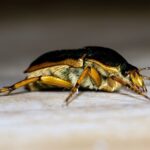Exploring Cockroaches’ Sensory Perception: Do They Enjoy Being Touched?

For centuries, cockroaches have been the subject of unwarranted dread and fear. Yet, despite their creepy reputation, these resilient creatures have always managed to fascinate scientists and researchers alike. As an experienced entomologist with a passion for delving into the intricate world of insects, I am often faced with intriguing questions about their behavior and physiology. One question that frequently comes up is whether cockroaches actually enjoy being touched. To shed light on this captivating topic, this article delves into the sensory perception of cockroaches, aiming to unravel their hidden responses and potentially reveal an unexpected side to these reviled insects.
Do cockroaches like to be touched?
Cockroaches, those elusive insects that have thrived for millions of years, continue to inspire curiosity and intrigue. One might wonder, do these creatures have any semblance of preference or pleasure when it comes to being touched? As an experienced entomologist, I am here to shed light on the sensory perception and reactions of cockroaches when confronted with touch stimuli. So, let’s delve into the fascinating world of cockroach physiology and behavior to find out if they enjoy being touched.
Let’s start by understanding the peculiar nature of cockroaches. These fascinating creatures are thigmotropic, meaning they are attracted to solid surfaces in contact with their bodies. They seek out cracks, crevices, and tight-fitting spaces, as if they are in search of a reassuring hug from their environment. Cockroaches love the feeling of something solid enveloping them, providing a sense of security and comfort. So, while they may not actively seek out touch from humans or other animals, they do appreciate the sensation of tactile stimuli.
To comprehend why cockroaches have such a strong affinity for tight spaces, let’s consider their ability to squeeze into remarkably thin gaps. These resilient insects have the remarkable talent of fitting into spaces as thin as a dime or a quarter. Just imagine effortlessly maneuvering through spaces that seem almost impossible for any creature to access. For cockroaches, touching tight cracks and crevices is not only a pleasurable experience but also a survival strategy that enables them to find shelter, warmth, and safety from potential threats.
It’s important to note that cockroaches have been around for millions of years, including during the Jurassic period. They have adapted and survived in a wide range of environments, proving their resilience and ability to navigate various challenges. Their strong drive to squeeze into tight spaces and their preference for tactile sensations contribute to their ability to find hidden, safe havens in our homes and surroundings.
However, it’s crucial to exercise caution when it comes to touching cockroaches. While they may appear harmless, these resilient insects can carry and spread diseases. They are known to harbor bacteria and other microorganisms that can lead to dysentery, diarrhea, cholera, leprosy, typhoid fever, plague, and viral diseases. Moreover, cockroach allergens can trigger allergies and exacerbate asthma symptoms. Therefore, it is advisable to avoid touching cockroaches directly, especially if you are uncertain about their hygiene and the potential health risks they may pose.
Furthermore, when contemplating whether cockroaches can derive pleasure or exhibit emotions through touch, it’s essential to remember that their behavior is predominantly driven by reflexes and environmental cues. Unlike humans or other animals, cockroaches do not possess emotions as we understand them. Their actions are primarily rooted in survival instincts and genetically programmed responses. So, while they may respond positively to tactile sensations, it doesn’t necessarily imply that they derive pleasure from being touched.
In conclusion, while cockroaches may appreciate the feeling of something solid touching their bodies and seek out tight spaces in search of refuge, it would be inaccurate to claim that they enjoy being touched. Their sensory perception is undoubtedly unique, driven by their thigmotropic nature and the need for protection. However, it is crucial to maintain caution and avoid direct contact with these insects due to their potential to carry diseases and trigger allergies. So, let us marvel at their incredible adaptability and resilience, but keep a respectful distance from these ancient creatures for our own well-being.
“While cockroaches appreciate the feeling of something solid touching their bodies, it would be inaccurate to claim they enjoy being touched.”
Cockroaches are creatures that can send shivers down your spine, especially when you discover some scary facts about them. Did you know that cockroaches can live without their heads for weeks? It’s true! If that isn’t enough to make your skin crawl, how about the fact that they can survive for up to a month without food? These resilient pests are truly masters of survival. If you’re brave enough, delve deeper into the terrifying world of cockroaches and uncover more spine-chilling facts by clicking here: scary facts about cockroaches.
Scientists Unveil the Unresolved Mystery of Cockroaches
[youtube v=”H_HxwLHX8mc”]
Cockroaches, thigmotropic insects that have withstood the test of time, continue to perplex homeowners and scientists alike. Despite the numerous attempts to eradicate these resilient creatures, they seem to persist in our living spaces. In this captivating study, scientists have delved into the world of cockroaches to uncover the reasons behind their uncanny ability to evade eradication.
A Closer Look at Cockroach Behavior
Cockroaches possess a unique attraction to solid surfaces in direct contact with their bodies. This thigmotropic behavior leads them to seek out tight cracks, crevices, and spaces, as it provides them with a sense of security and comfort. Their inclination towards touching tight spaces serves not only as a pleasurable experience but also as a vital survival strategy. As one scientist notes, “Cockroaches have evolved to thrive in various environments, and their ability to squeeze through the tightest of spaces contributes to their resilience.”
The Intricate World of Cockroach Survival
These ancient insects have managed to survive for millions of years, adapting to different conditions and environments. Their remarkable adaptability is evident in their ability to thrive in both urban and natural settings. However, caution must be exercised when it comes to interacting with cockroaches. They have been known to carry and spread diseases, making direct contact with them a potential health risk. It is crucial to admire their adaptability from a distance, as the well-being of humans should always be prioritized.
The Emotional Experiences of Cockroaches
While it is tempting to attribute emotions to all creatures, including cockroaches, it is important to acknowledge that their emotional experiences differ vastly from those of humans or other animals. While cockroaches may exhibit positive responses to tactile sensations, this should not be misconstrued as deriving pleasure from being touched. As the scientists emphasize, “It is crucial to maintain caution and avoid direct contact with cockroaches due to potential health risks.”
Embracing Respectful Distance
In conclusion, the persistence of cockroaches in our homes serves as a testament to their adaptability and resilience. However, maintaining a respectful distance is crucial for the well-being of humans. While we admire their fascinating survival strategies, it is essential to exercise caution and avoid direct contact with these insects to reduce the risk of potential health hazards.
“Admire the adaptability and resilience of cockroaches, but keep a respectful distance for our own well-being.”
As scientists strive to unravel the mysteries of these ancient creatures, the age-old conundrum of eradicating cockroaches from our lives continues. By acknowledging the unique behaviors and survival instincts of these enduring insects, we can develop a better understanding of their existence and coexist with them while ensuring the health and safety of our own living environments.

FAQ
Do cockroaches enjoy being touched?
Cockroaches do not have emotions as we understand them, and their behavior is mostly driven by reflexes and environmental cues. While they may not experience pleasure or enjoyment from being touched, they are thigmotropic, meaning they like feeling something solid in contact with their bodies, preferably on all sides. They seek out cracks and crevices and squeeze into spaces that offer them a tight fit. So, while they may not enjoy being touched in the same way humans do, they do seek out physical contact for their own physiological needs.
How small of a space can cockroaches fit into?
Cockroaches can fit into very thin spaces, such as cracks as thin as a dime or a quarter. Their flexible exoskeleton and ability to flatten their bodies allow them to squeeze through tight spaces with ease. This adaptability helps them find shelter and navigate through various environments, making them highly resilient and able to survive in diverse conditions.
What do cockroaches eat?
Cockroaches are scavengers and have a wide-ranging diet. They can eat almost anything, including sugar, grease, glue, soap, and even hair. Their opportunistic feeding behavior allows them to thrive in different habitats, as they can find food in various sources. This adaptability and ability to consume a variety of substances contribute to their survival and presence in different environments.
Do cockroaches have any protective mechanisms for their offspring?
Yes, cockroaches protect their offspring by laying eggs and enveloping them in a thick protective case called an ootheca. This ootheca safeguards the eggs from external threats and provides a suitable environment for their development. The female cockroach carefully chooses the location to deposit the ootheca, ensuring the safety and survival of her young.
Can cockroaches spread diseases?
Yes, cockroaches can carry and spread diseases. They can harbor bacteria and other microorganisms linked to dysentery, diarrhea, cholera, leprosy, typhoid fever, plague, and viral diseases. Cockroaches can contaminate food and surfaces by coming into contact with bacteria and spreading them through their feces and body parts. It is important to maintain good hygiene and prevent cockroach infestations to minimize the risk of disease transmission.
- Unlock Water’s Symbolism: A Cross-Cultural Exploration - April 20, 2025
- Identify Black and White Snakes: Venomous or Harmless? - April 20, 2025
- Unlocking Potential: Origins High School’s NYC Story - April 20, 2025















